Contemporary Tendencies in Snow Cover, Winter Precipitation, and Winter Air Temperatures in the Mountain Regions of Bulgaria
Abstract
1. Introduction
2. Materials and Methods
2.1. Data and Station Information
2.2. Methods
3. Results
3.1. Trend Analysis with the Mann–Kendall Trend Test
3.1.1. Seasonal Snow Cover Maximum (Hmax)
3.1.2. Winter Precipitation Amounts (PAs)
3.1.3. Winter Mean Air Temperatures (Tmean)
3.2. Pettitt’s Test and LOWESS
4. Discussion
Author Contributions
Funding
Data Availability Statement
Acknowledgments
Conflicts of Interest
References
- Beniston, M.; Diaz, H.F.; Bradley, R.S. Climatic change at high elevation sites; a review. Clim. Change 1997, 36, 233–251. [Google Scholar] [CrossRef]
- Keller, F.; Goyette, S.; Beniston, M. Sensitivity analysis of snow cover to climate change scenarios and their impact on plant habitats in Alpine Terrain. Clim. Change 2005, 72, 299–319. [Google Scholar] [CrossRef]
- Körner, C. Alpine Plant Life; Springer-Verlag: Berlin/Heidelberg, Germany; New York, NY, USA, 1999; 338p. [Google Scholar]
- Beniston, M.; Keller, F.; Koffi, B.; Goyette, S. Estimates of snow accumulation and volume in the Swiss Alps under changing climatic conditions. Theor. Appl. Climatol. 2003, 76, 125–140. [Google Scholar] [CrossRef]
- Elsasser, H.; Messerli, P. The vulnerability of the snow industry in the Swiss Alps. Mt. Res. Dev. 2001, 21, 335–339. [Google Scholar]
- Strasser, U. Snow loads in a changing climate: New risks? Nat. Hazards Earth Syst. Sci. 2008, 8, 1–8. [Google Scholar] [CrossRef]
- Haeberli, W.; Beniston, M. Climate Change and its Impacts on Glaciers and Permafrost in the Alps. Ambio 1998, 27, 258–265. [Google Scholar]
- Beniston, M. (Ed.) Mountain Environments in Changing Climates; Routledge Publishing Co.: London, UK; New York, NY, USA, 1994; p. 492. [Google Scholar]
- Beniston, M.; Rebetez, M. Regional Behavior of Minimum Temperatures in Switzerland for the Period 1979–1993. Theor. Appl. Clim. 1996, 53, 231–243. [Google Scholar] [CrossRef]
- Giorgi, F.; Mearns, L.O. Approaches to the Simulation of Regional Climate Change. Rev. Geophys. 1991, 29, 191–216. [Google Scholar] [CrossRef]
- Katz, R.W.; Brown, B.G. Extreme Events in a Changing Climate: Variability is More Important than Averages. Clim. Change 1992, 21, 289–302. [Google Scholar] [CrossRef]
- IPCC; Watson, R.T.; Zinyowera, M.; Moss, R.H. (Eds.) Climate Change 1995; The IPCC Second Assessment Report; Cambridge University Press: Cambridge, UK; New York, NY, USA, 1996; p. 862. [Google Scholar]
- Rebetez, M.; Beniston, M. Changes in temperature variability in relation to shifts in mean temperatures in the swiss alpine region this century. In The Impacts of Climate Variability on Forests; Beniston, M., Innes, J.L., Eds.; Lecture Notes in Earth Sciences; Springer: Berlin/Heidelberg, Germany, 1998; Volume 74. [Google Scholar] [CrossRef]
- Beniston, M. Variations in snow depth and duration in the Swiss Alps over the last 50 years; links to changes in the large scale climatic forcings. Clim. Change 1997, 36, 281–300. [Google Scholar] [CrossRef]
- Hantel, M.; Ehrendorfer, M.; Haslinger, A. Climate sensitivity of snow cover duration in Austria. Int. J. Climatol. 2000, 20, 615–640. [Google Scholar] [CrossRef]
- Beniston, M.; Keller, F.; Goyette, S. Snow pack in the Swiss Alps under changing climatic conditions: An empirical approach for climate impacts studies. Theor. Appl. Climatol. 2003, 74, 19–31. [Google Scholar] [CrossRef]
- Brown, R.; Petkova, N. Snow cover variability in Bulgarian mountainous regions, 1931–2000. Int. J. Climatol. 2007, 27, 1215–1229. [Google Scholar] [CrossRef]
- Uhlmann, B.; Goyette, S.; Beniston, M. Sensitivity analysis of snow patterns in Swiss ski resorts to shifts in temperature, precipitation and humidity under conditions of climate change. Int. J. Climatol. 2009, 29, 1048–1055. [Google Scholar] [CrossRef]
- Schöner, W.; Auer, I.; Böhm, R. Long term trend of snow depth at Sonnblick (Austrian Alps) and its relation to climate change. Hydrol. Process. 2009, 23, 1052–1063. [Google Scholar] [CrossRef]
- Beniston, M.; Uhlmann, B.; Goyette, S.; Lopez-Moreno, J.I. Will snow-abundant winters still exist in the Swiss Alps in an enhanced greenhouse climate? Int. J. Climatol. 2011, 31, 1257–1263. [Google Scholar] [CrossRef]
- Pepin, N.; Bradley, R.S.; Diaz, H.; Baraer, M.; Caceres, E.B.; Forsythe, N.; Fowler, H.; Greenwood, G.; Hashmi, M.Z.; Liu, X.D.; et al. Elevation-Dependent Warming in Mountain Regions of the World. Nat. Clim. Change 2015, 5, 424–430. [Google Scholar] [CrossRef]
- Micu, D. Snow pack in the Romanian Carpathians under changing climatic conditions. Meteorog. Atmos. Phys. 2009, 105, 1–16. [Google Scholar] [CrossRef]
- Nikolova, N.; Faško, P.; Lapin, M.; Švec, M. Changes in snowfall/precipitation-day ratio in Slovakia and their linkages with air temperature and precipitation. Contrib. Geophys. Geod. 2013, 43, 141–155. [Google Scholar] [CrossRef][Green Version]
- Gentilucci, M.; Catorci, A.; Panichella, T.; Moscatelli, S.; Hamed, Y.; Missaoui, R.; Pambianchi, G. Analysis of Snow Cover in the Sibillini Mountains in Central Italy. Climate 2023, 11, 72. [Google Scholar] [CrossRef]
- Beniston, M.; Farinotti, D.; Stoffel, M.; Andreassen, L.M.; Coppola, E.; Eckert, N.; Fantini, A.; Giacona, F.; Hauck, C.; Huss, M.; et al. The European mountain cryosphere: A review of its current state, trends, and future challenges. Cryosphere 2018, 12, 759–794. [Google Scholar] [CrossRef]
- Matiu, M.; Crespi, A.; Bertoldi, G.; Carmagnola, C.M.; Marty, C.; Morin, S.; Schöner, W.; Berro, D.C.; Chiogna, G.; De Gregorio, L.; et al. Observed snow depth trends in the European Alps: 1971 to 2019. The Cryosphere 2021, 15, 1343–1382. [Google Scholar] [CrossRef]
- Staneva, B. On the Regime of Snow Cover in Bulgaria, Works of the Hydro-Meteorological Service; State Publishing House “Science and Art”: Sofia, Bulgaria, 1955; Volume IV, pp. 213–269. [Google Scholar]
- Hershkovich, E. Regime of Snow Cover in Bulgaria, Works of the Hydro-Meteorological Service; State Publishing House “Science and Art”: Sofia, Bulgaria, 1955; Volume IV, pp. 271–328. [Google Scholar]
- Nikolov, D.; Dimitrov, C. Assessment of the long term variability of the snow cover in the Vitosha mountain, 2021, SGEM Conference Paper. In Proceedings of the 21st SGEM International Multidisciplinary Scientific GeoConference Proceedings 2021, Albena, Bulgaria, 16–22 August 2021. [Google Scholar] [CrossRef]
- Nikolov, D.; Dimitrov, C. Analysis of the variability of the winter precipitations and temperatures in two mountain regions of Bulgaria, 2022, SGEM Conference Paper. In Proceedings of the 22nd SGEM International Multidisciplinary Scientific GeoConference Proceedings 2022, Vienna, Austria, 6–8 December 2022. [Google Scholar] [CrossRef]
- Mann, H.B. Nonparametric tests against trend. Econometrica 1945, 13, 245–259. [Google Scholar] [CrossRef]
- Kendall, M.G. Rank Correlation Methods, 2nd ed.; Hafner: New York, NY, USA, 1972. [Google Scholar]
- Alexandersson, H. A homogeneity test applied to precipitation data. J. Climatol. 1986, 6, 661–675. [Google Scholar] [CrossRef]
- Pettitt, A.N. A non-parametric approach to the change point problem. J. R. Stat. Soc. Ser. C Appl. Stat. 1979, 28, 126–135. [Google Scholar] [CrossRef]
- Cleveland, W.S.; Devlin, S.J. Locally Weighted Regression: An Approach to Regression Analysis by Local Fitting. J. Am. Stat. Assoc. 1988, 83, 596–610. [Google Scholar] [CrossRef]
- Pohlert, T. Trend: Non-Parametric Trend Tests and Change-Point Detection. 2024. Available online: https://cran.r-project.org/web/packages/trend/index.html (accessed on 18 February 2025).
- Pohlert, T.; Hillebrand, G.; Breitung, V. Trends of persistent organic pollutants in the suspended matter of the River Rhine. Hydrol. Process. 2011, 25, 3803–3817. [Google Scholar] [CrossRef]
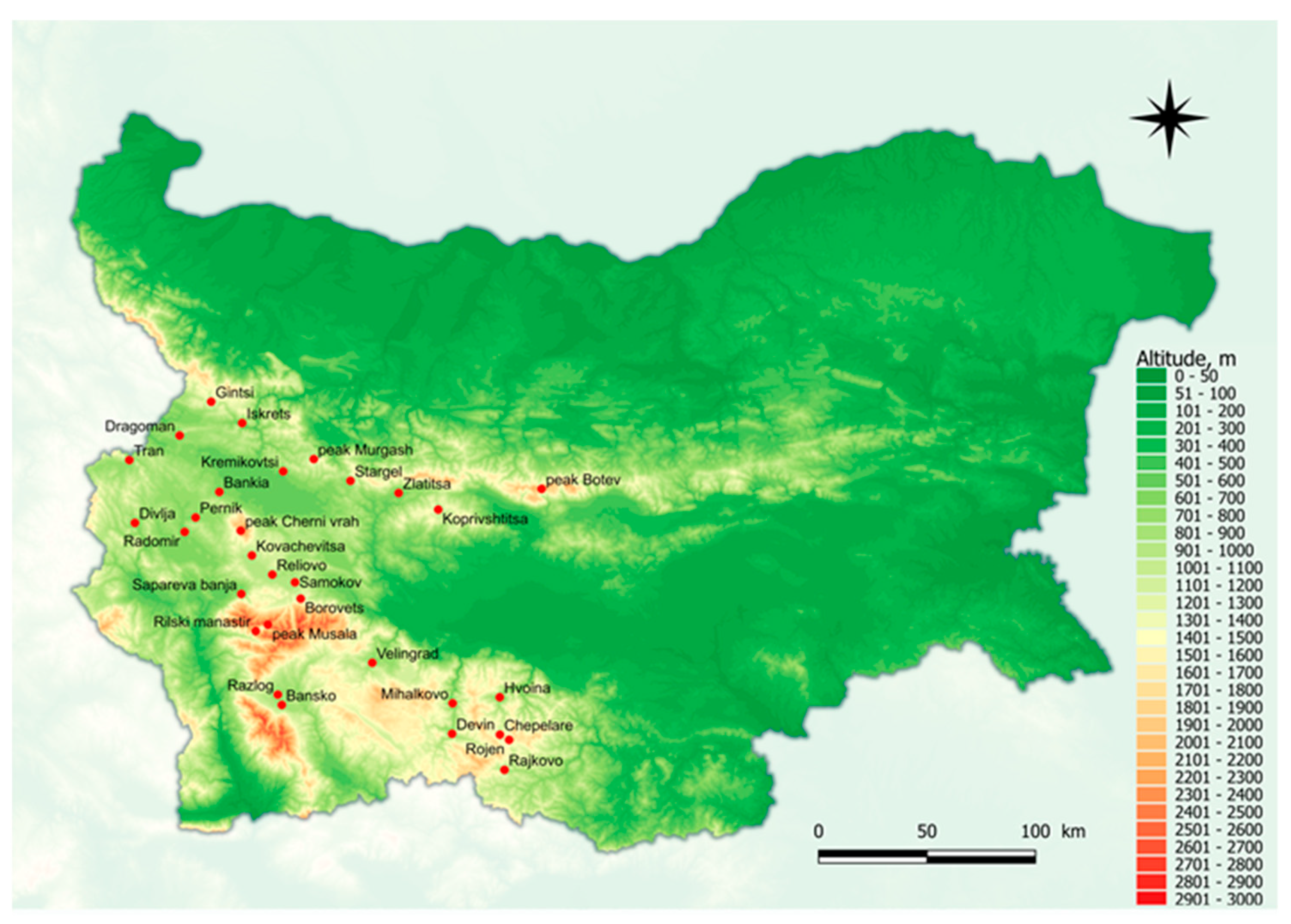
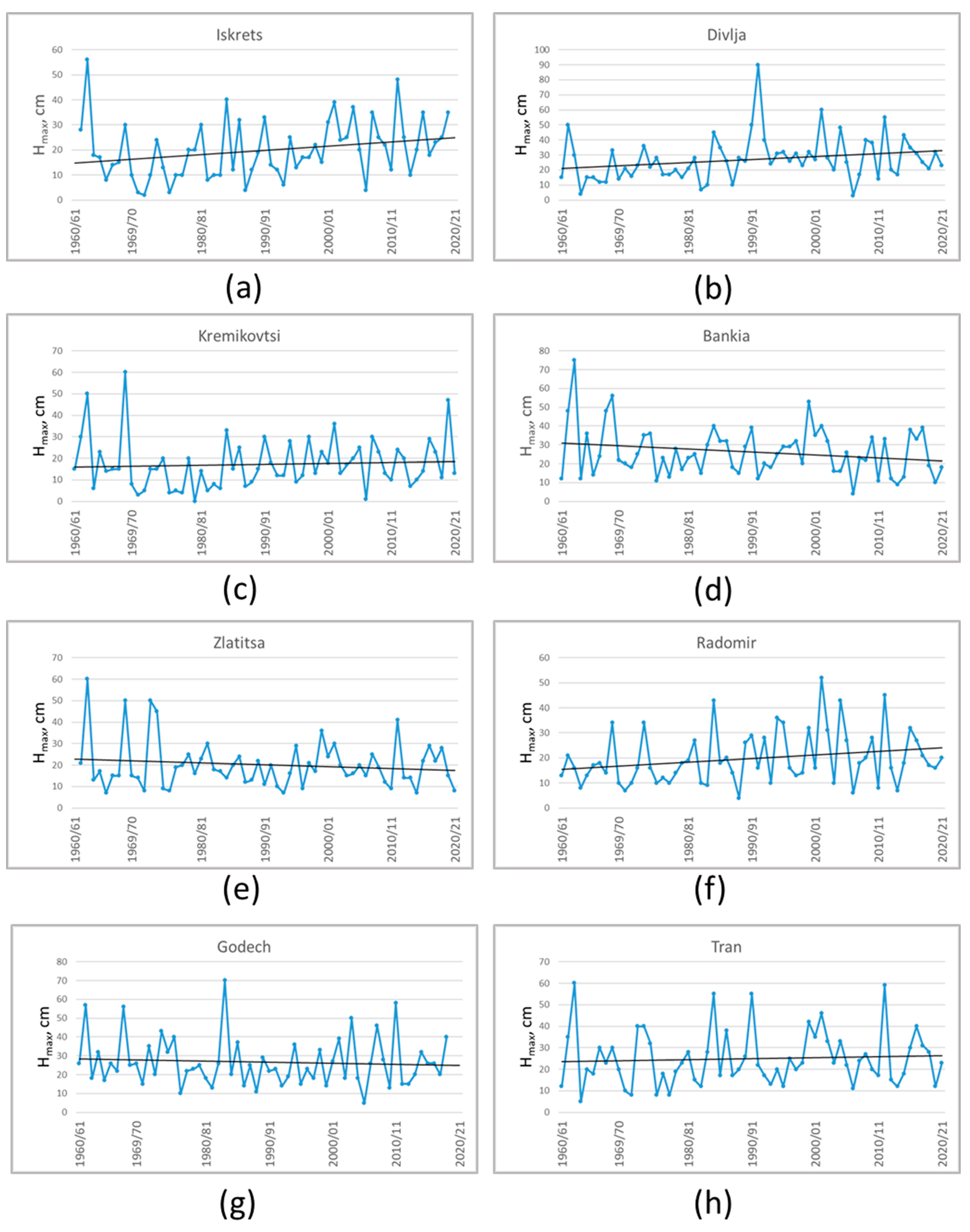

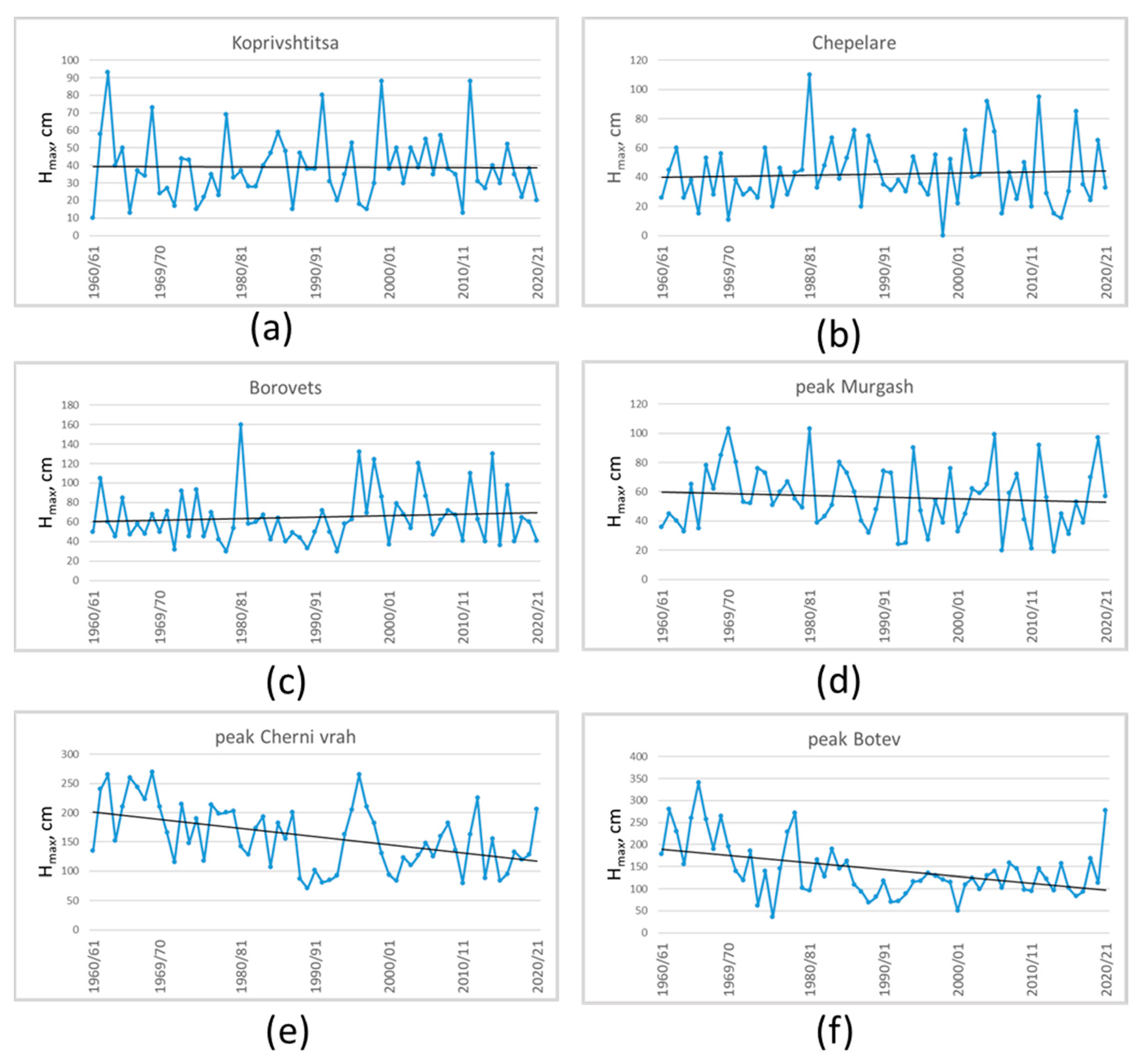

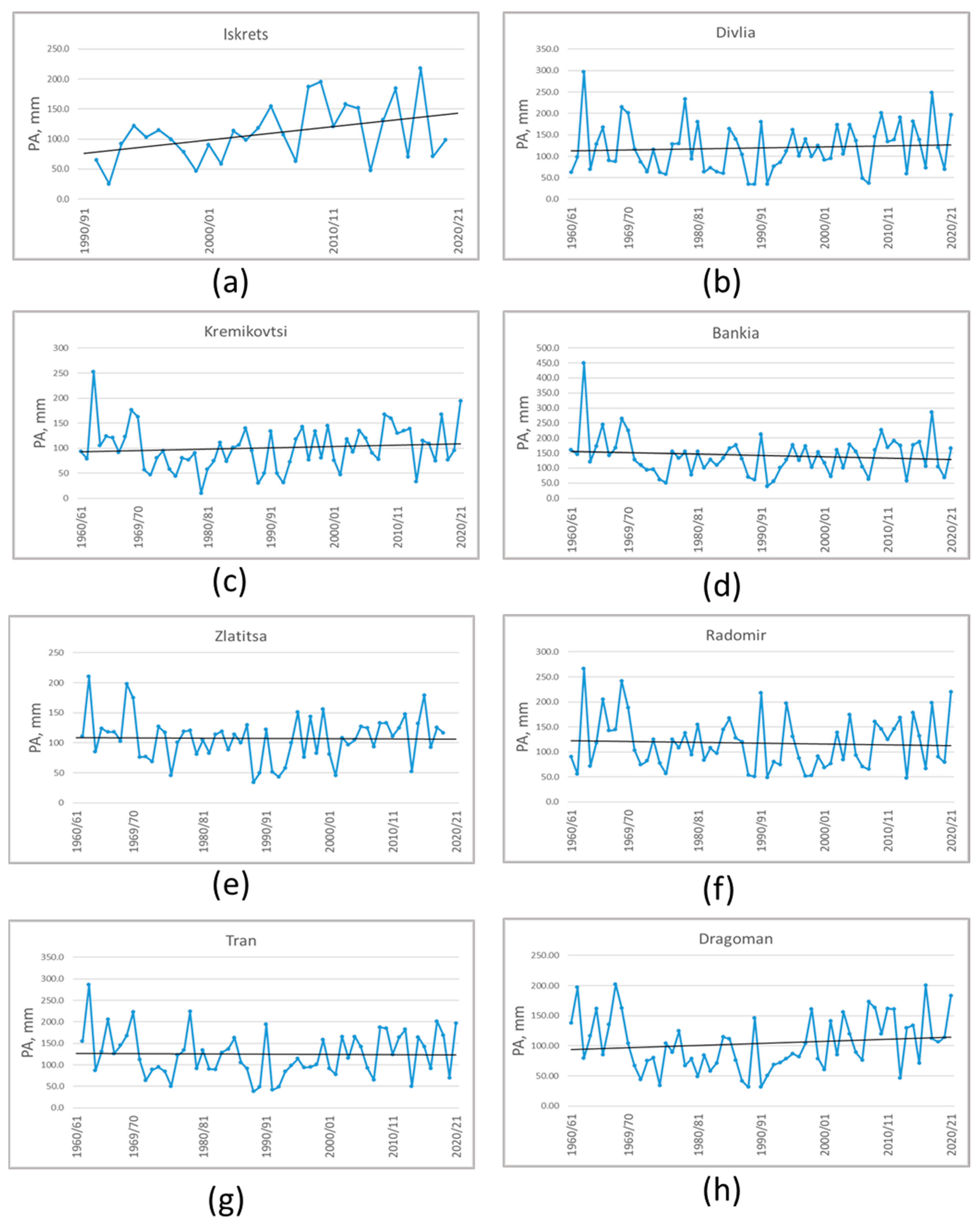
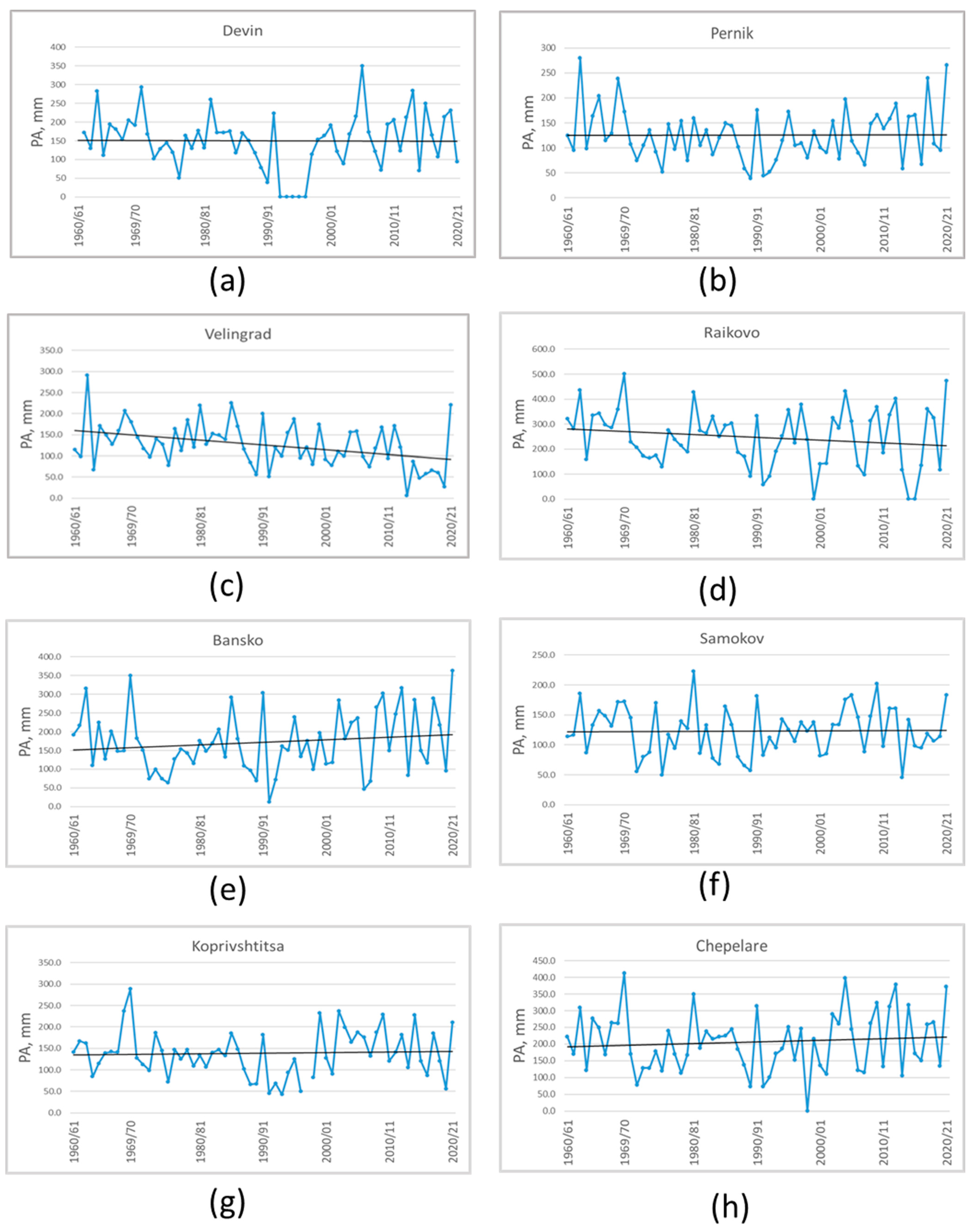
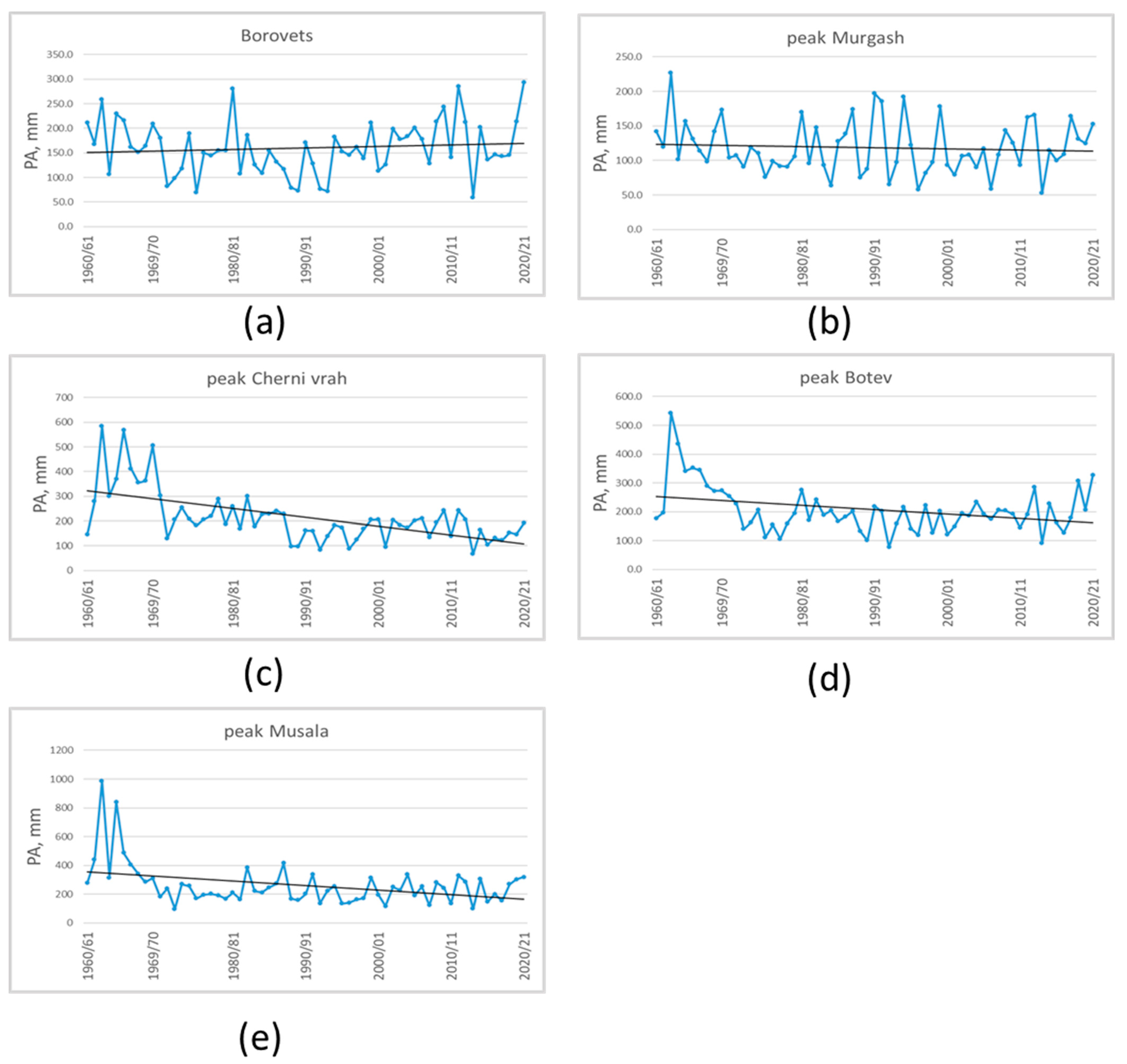
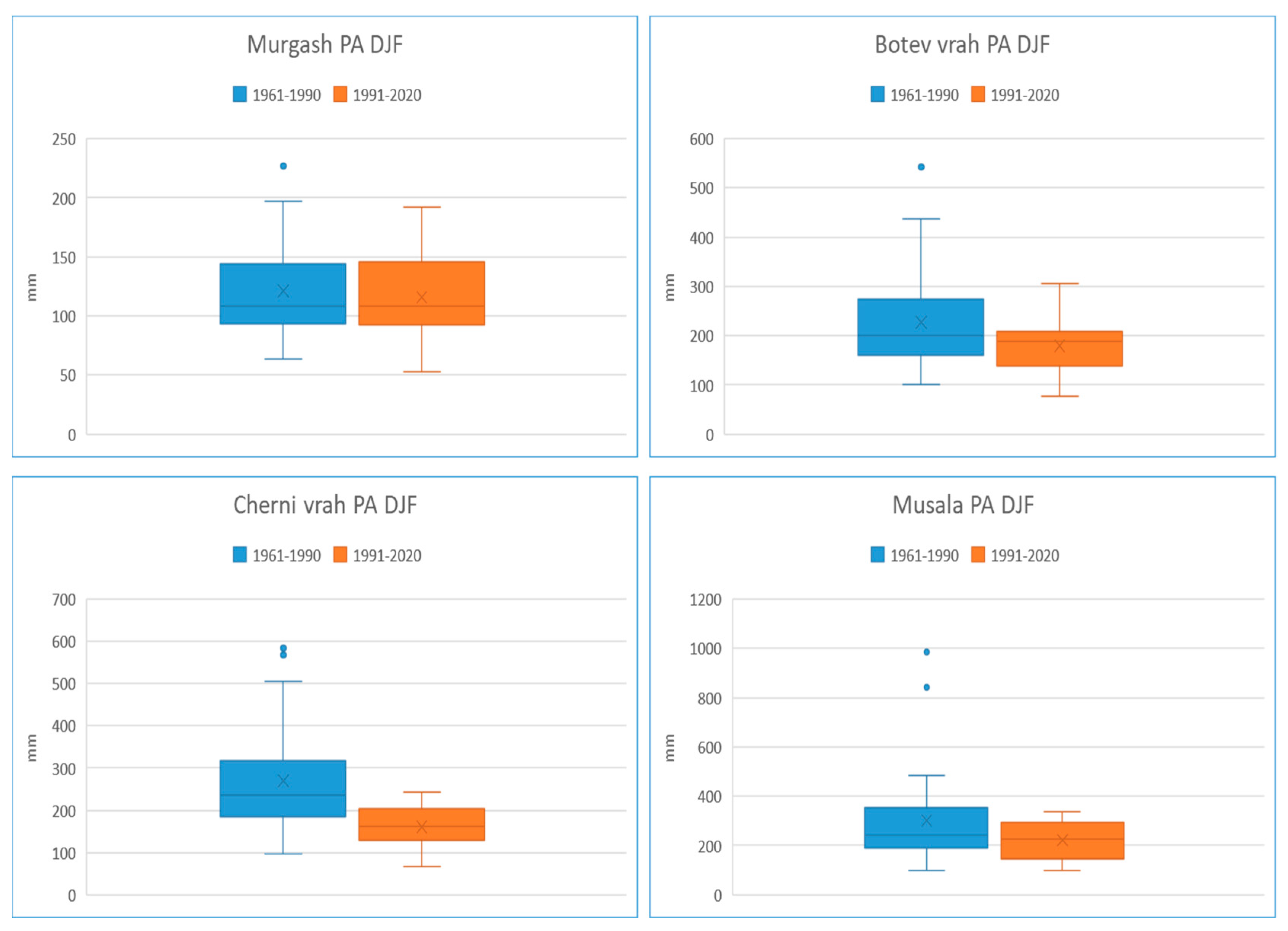

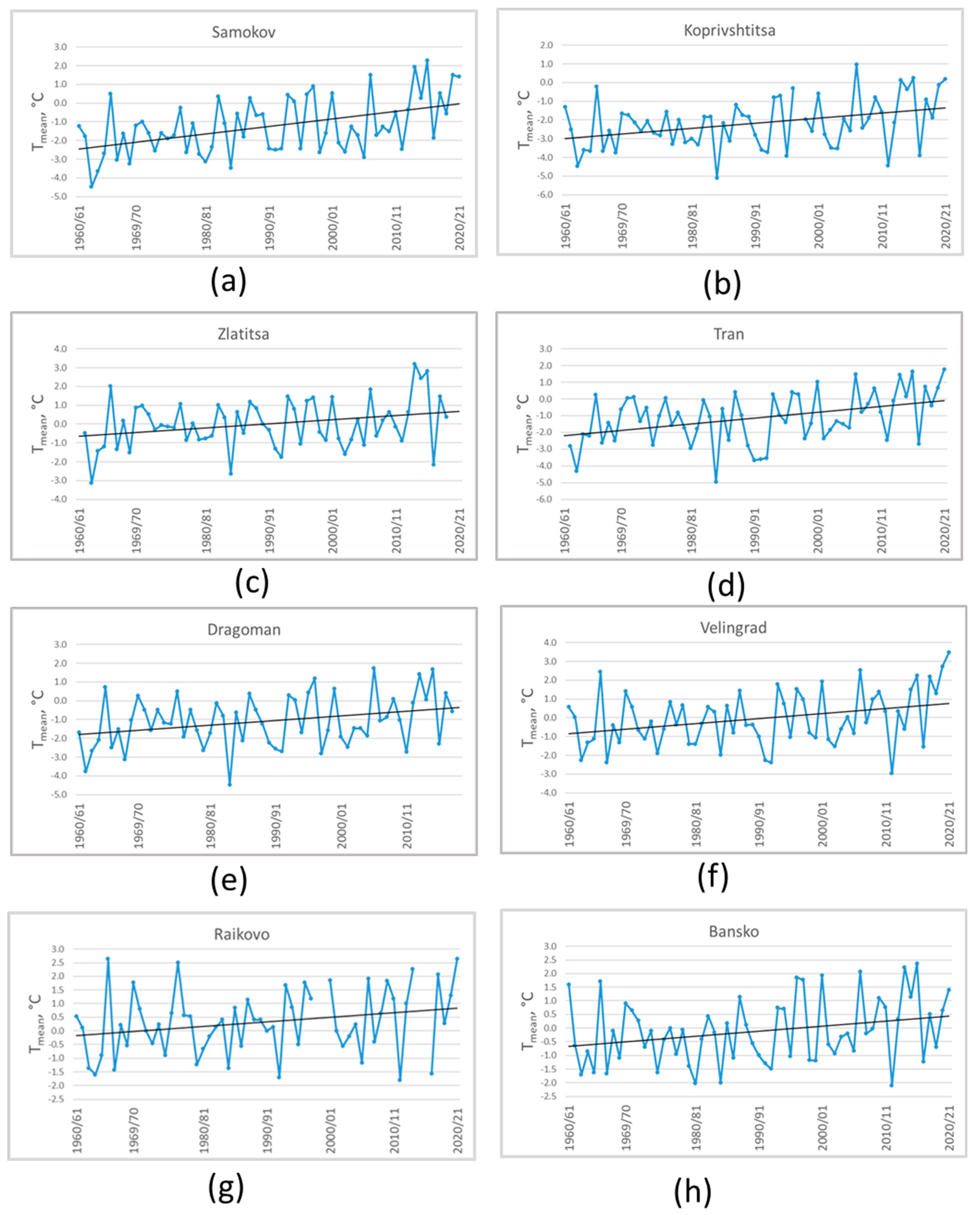
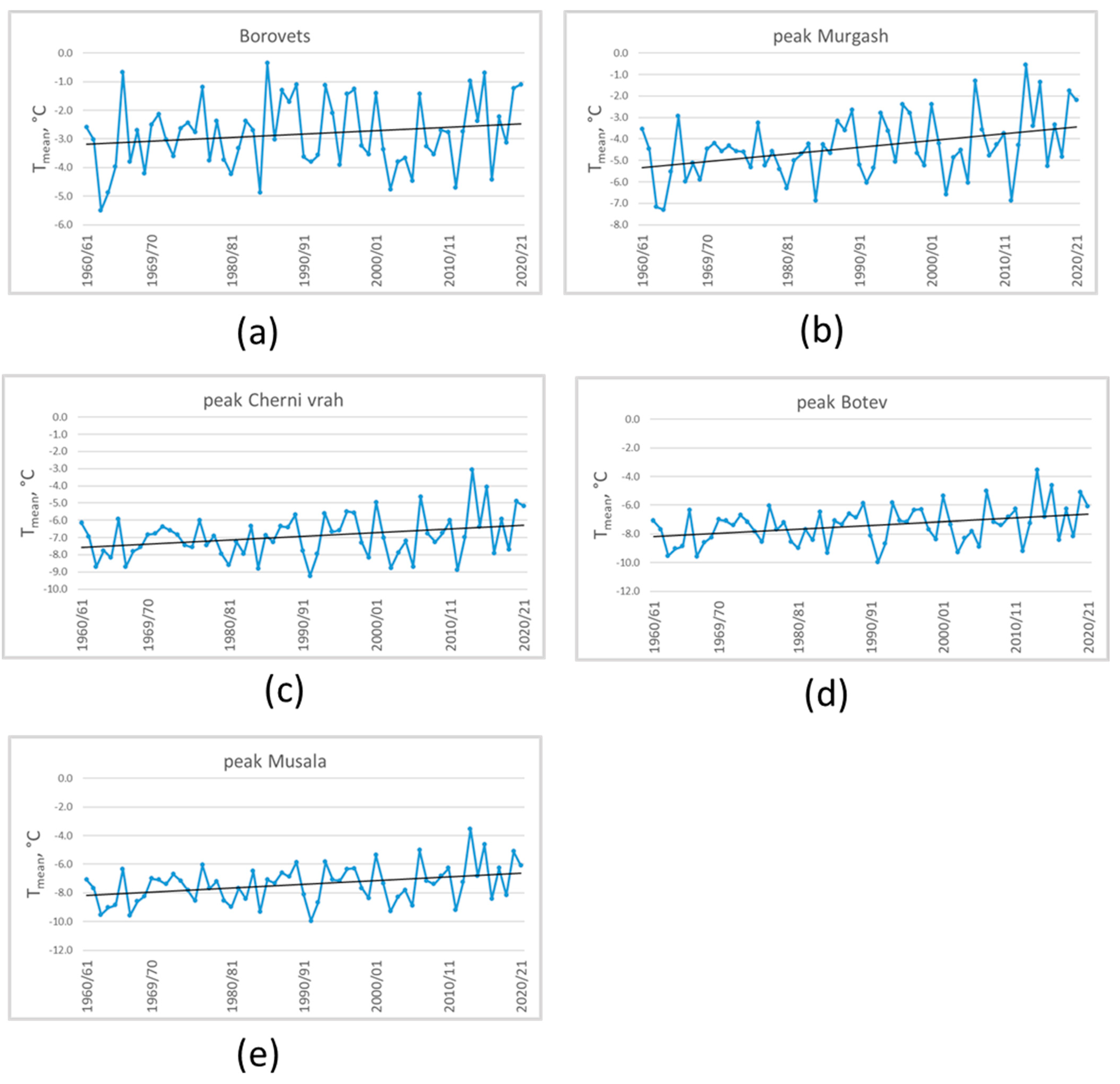
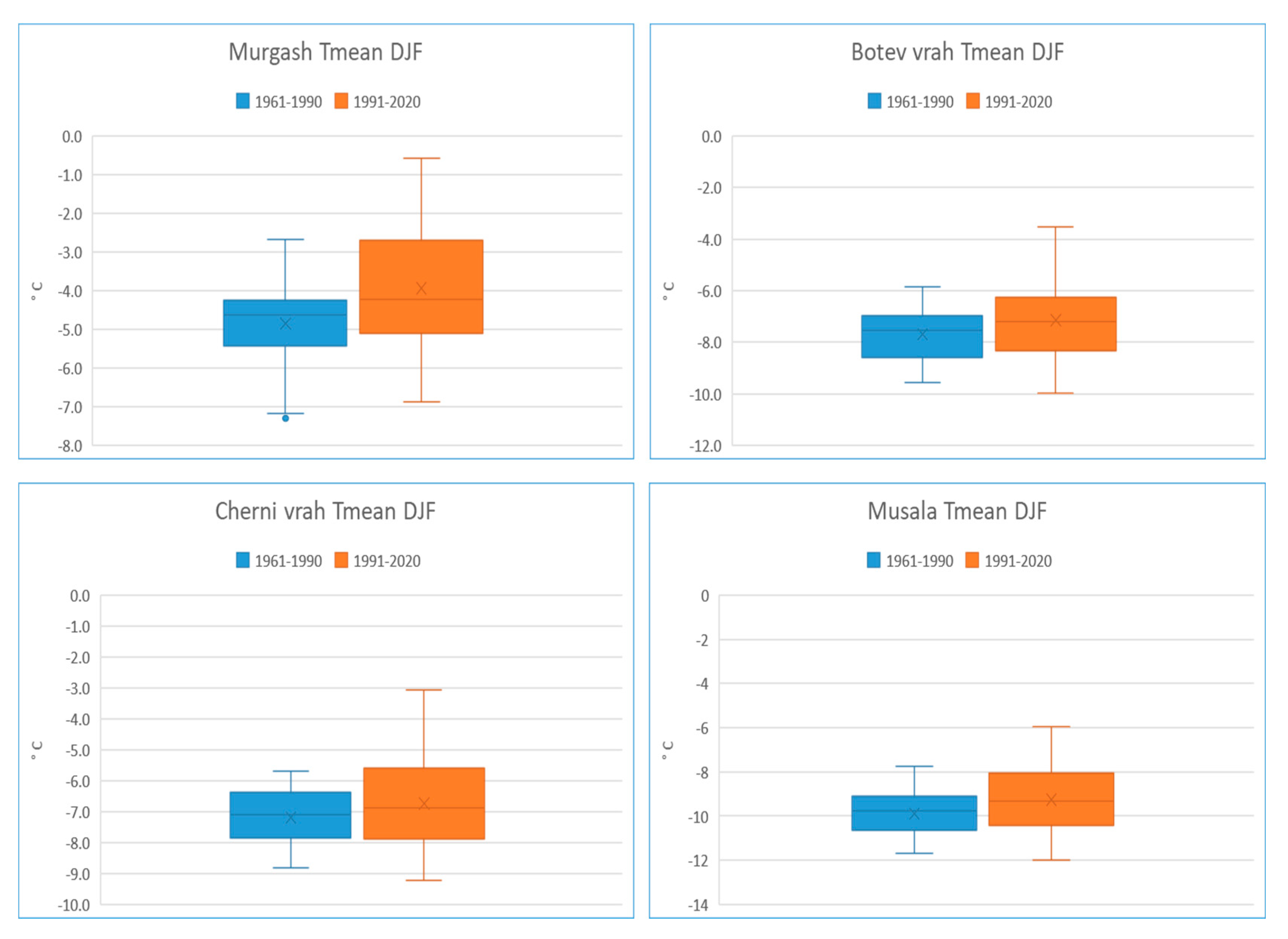

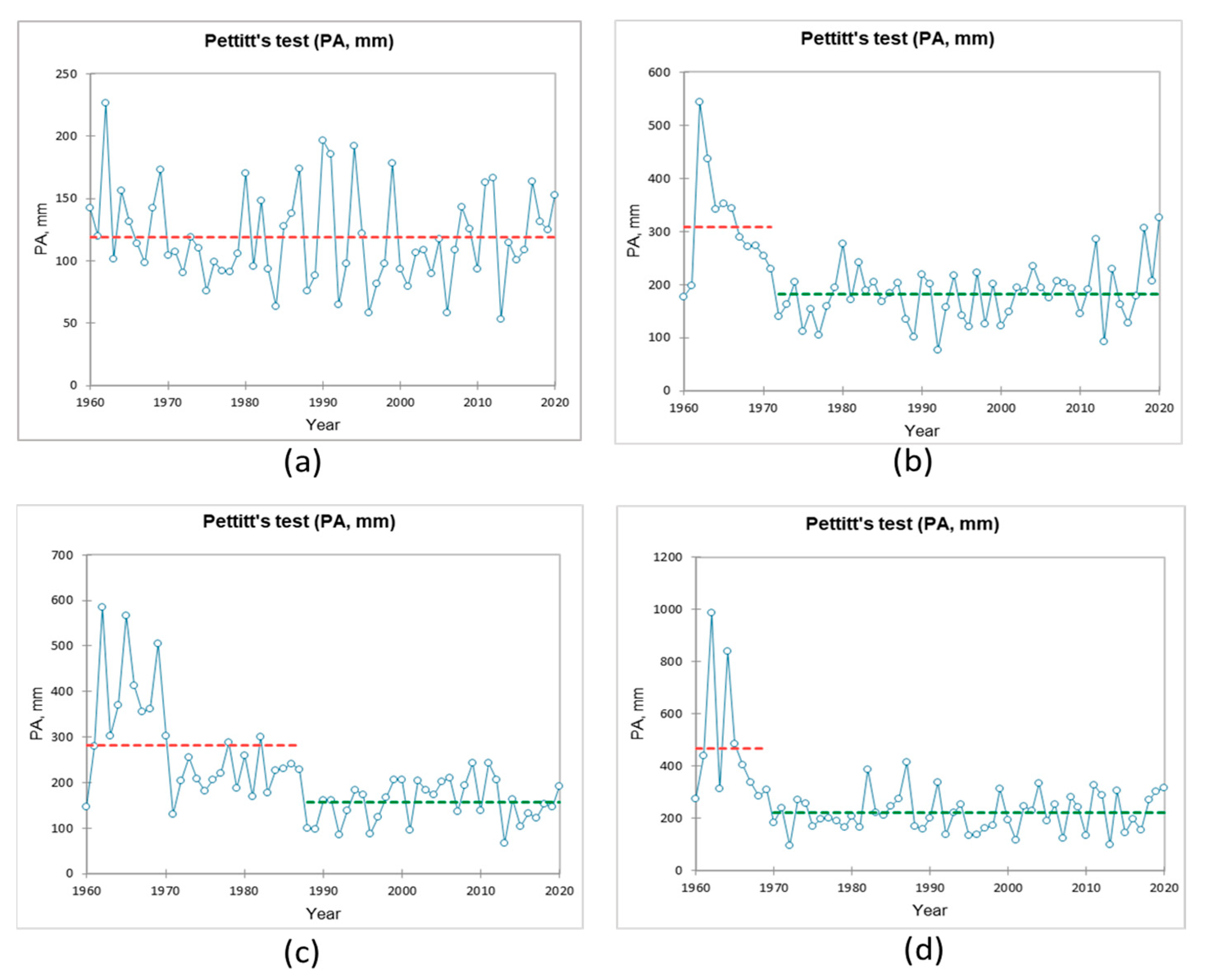
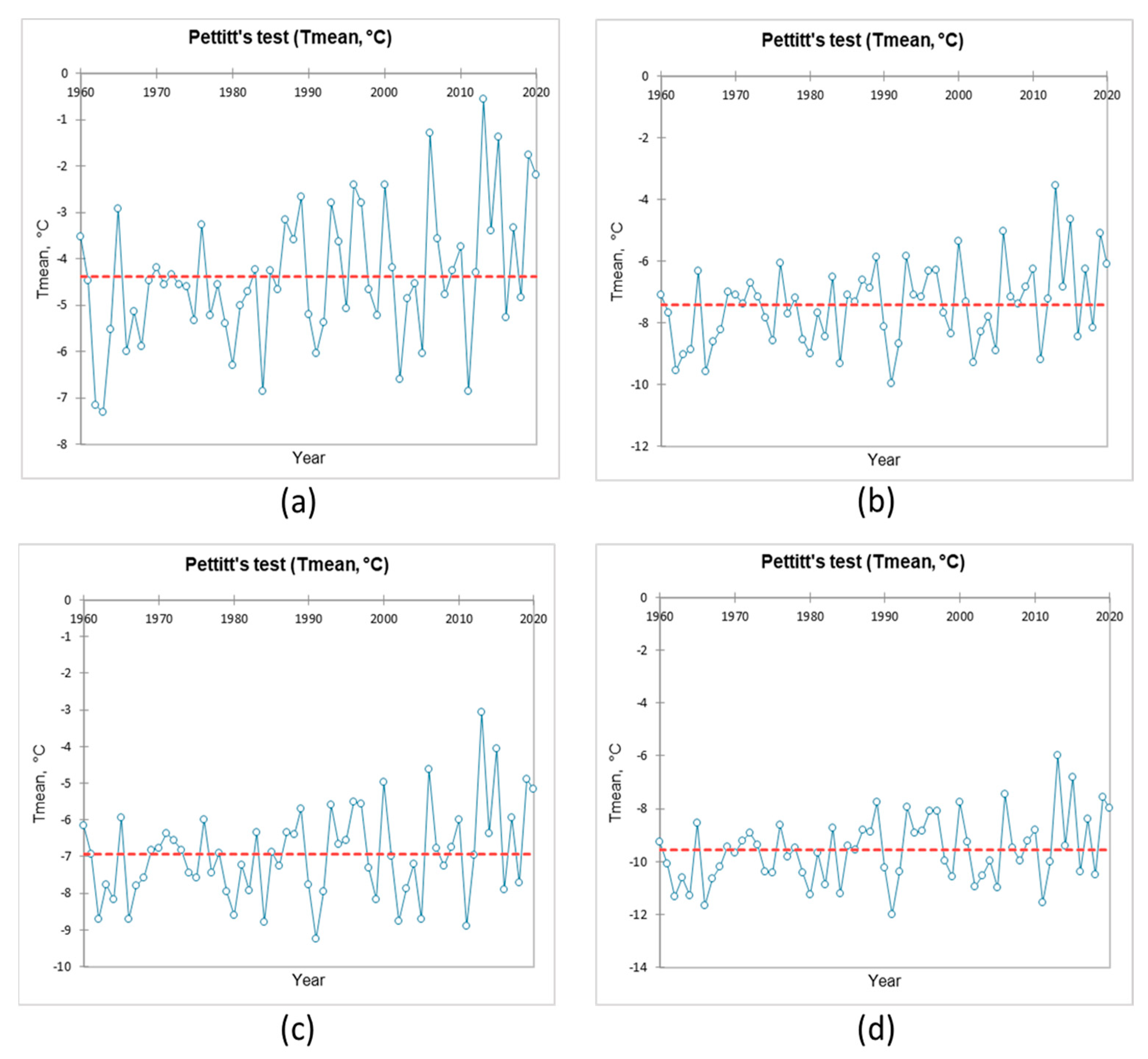
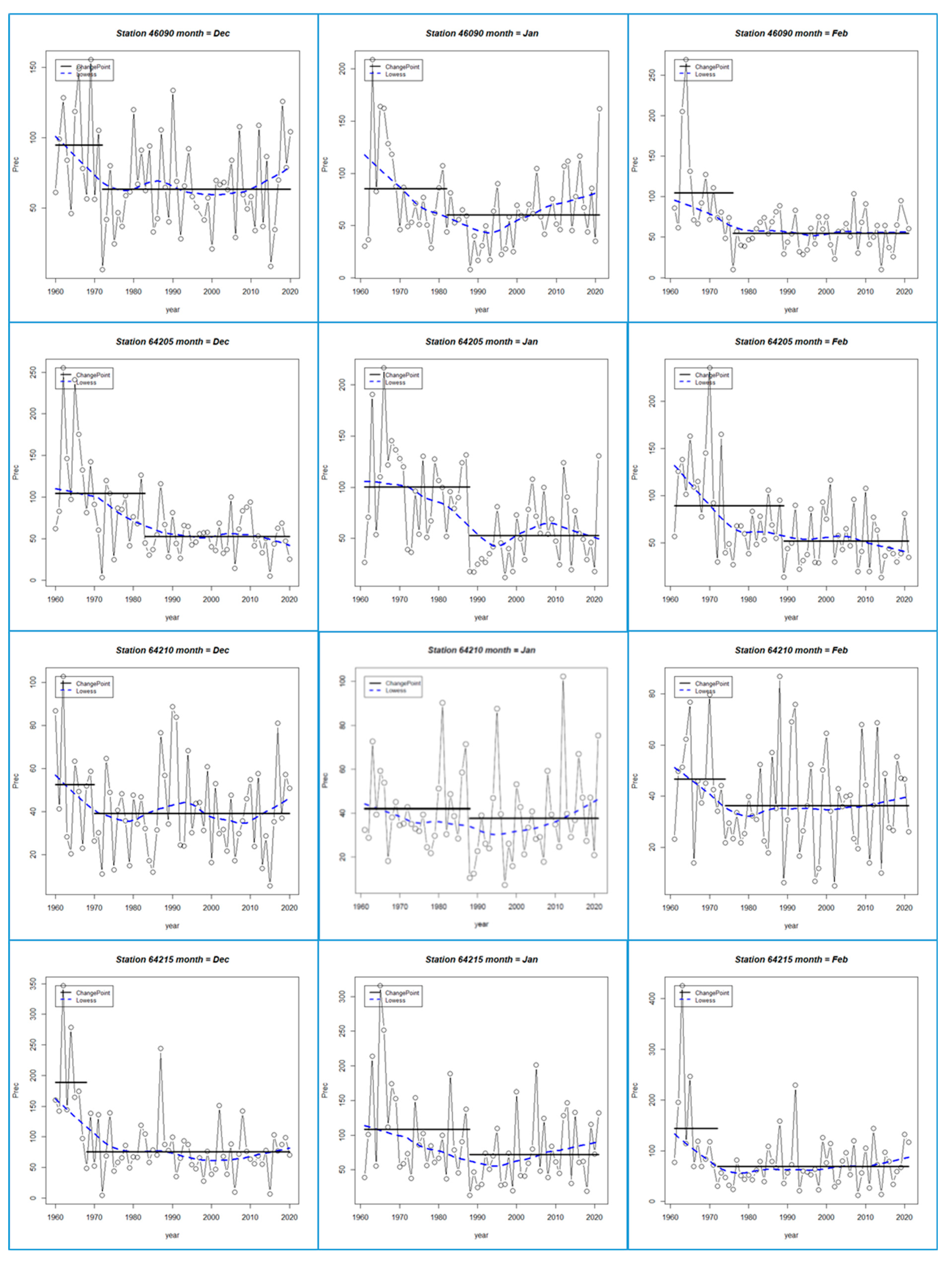
| Station Name | Altitude, m | Hmax | Tmean | PA |
|---|---|---|---|---|
| Iskrets | 527 | 1960–2021 | 1991–2020 | 1991–2020 |
| Divlja * | 600 | 1960–2021 | 1967–2021 | 1960–2021 |
| Kremikovtsi * | 627 | 1960–2021 | NA | 1960–2021 |
| Bankia | 648 | 1960–2021 | 1973–2021 | 1960–2021 |
| Zlatitsa | 674 | 1961–2020 | 1961–2019 | 1961–2020 |
| Radomir | 691 | 1960–2021 | 1960–1990 | 1960–2021 |
| Godech * | 692 | 1960–2015 | NA | NA |
| Tran | 706 | 1961–2021 | 1961–2019 | 1961–2019 |
| Dragoman | 715 | 1960–2021 | 1961–2019 | 1961–2019 |
| Mihalkovo * | 717 | 1960–2019 | NA | NA |
| Devin * | 723 | 1960–2021 | NA | 1960–2021 |
| Pernik | 726 | 1960–2021 | 1960–2021 | 1960–2021 |
| Velingrad | 743 | 1960–2021 | 1960–2021 | 1960–2021 |
| Hvoina * | 728 | 1960–2021 | 1966–2021 | 1960–2021 |
| Separeva Banja | 746 | 1960–2021 | 1960–1991 | 1960–2021 |
| Raikovo | 868 | 1960–2021 | 1960–2021 | 1960–2021 |
| Stargel * | 903 | 1960–2021 | NA | NA |
| Reliovo * | 904 | 1960–2021 | NA | NA |
| Bansko | 917 | 1960–2021 | 1960–2021 | 1960–2021 |
| Samokov | 926 | 1960–2021 | 1960–2021 | 1960–2021 |
| Kovachevtsi * | 1026 | 1960–2021 | NA | NA |
| Koprivshtisa | 1045 | 1953–2021 | 1960–2021 | 1960–2021 |
| Gintsi * | 1073 | 1960–2021 | NA | NA |
| Rilski manastir * | 1127 | 1960–2021 | 1960–1991 | 1960–2021 |
| Chepelare | 1150 | 1960–2021 | 1960–2021 | 1960–2021 |
| Borovets | 1264 | 1960–2021 | 1960–2021 | 1960–2021 |
| Peak Murgash | 1687 | 1960–2021 | 1960–2021 | 1960–2021 |
| Rojen * | 1750 | 1983–2021 | 1983–2021 | 1983–2021 |
| Peak Cherni vrah | 2286 | 1960–2021 | 1960–2021 | 1960–2021 |
| Peak Botev | 2376 | 1960–2021 | 1960–2021 | 1960–2021 |
| Peak Musala | 2925 | NA | 1960–2021 | 1960–2021 |
| Station Name | Altitude, m | Averaged for DJF | December | January | February |
|---|---|---|---|---|---|
| Divlja | 644 | −0.01 | −0.13 | 0.12 | −0.17 |
| Zlatitza | 680 | 0.44 | −0.18 | 0.64 | 0.71 |
| Tran | 706 | 0.69 | 0.54 | 1.14 | 0.44 |
| Pernik | 710 | −0.11 | −0.30 | 0.24 | 0.04 |
| Dragoman | 715 | 0.52 | 0.56 | 1.02 | 0.60 |
| Hvoina | 728 | −0.15 | −0.41 | 0.24 | −0.09 |
| Velingrad | 743 | 0.51 | 0.27 | 0.73 | 0.82 |
| Raikovo | 868 | 0.38 | −0.07 | 0.82 | 0.44 |
| Bansko | 917 | 0.54 | 0.19 | 0.77 | 0.92 |
| Samokov | 1029 | 0.94 | 0.46 | 1.47 | 1.18 |
| Koprivshtitza | 1045 | 0.83 | 0.48 | 0.84 | 0.72 |
| Chepelare | 1150 | 0.01 | −0.28 | 0.22 | 0.34 |
| Borovetz | 1264 | 0.04 | −0.02 | 0.45 | 0.29 |
| Murgash | 1687 | 0.92 | 0.45 | 1.03 | 1.14 |
| Boetvvrah | 2376 | 0.58 | 0.19 | 0.75 | 0.70 |
| Cherni vrah | 2290 | 0.56 | 0.36 | 0.72 | 0.60 |
| Musala | 2922 | 0.54 | 0.44 | 0.74 | 0.64 |
| Station Name | Altitude, m | Hmax | PA | Tmean | |||
|---|---|---|---|---|---|---|---|
| Slope | p-Value | Slope | p-Value | Slope | p-Value | ||
| Iskrets | 527 | 0.169 | 0.009 | 2.247 | 0.049 | 0.033 | 0.293 |
| Divlja | 600 | 0.198 | 0.021 | 0.230 | 0.302 | 0.004 | 0.935 |
| Kremikovtsi | 627 | 0.042 | 0.100 | 0.259 | 0.237 | x | x |
| Bankia | 648 | −0.075 | 0.370 | −0.025 | 0.901 | 0.020 | 0.142 |
| Zlatitsa | 674 | −0.088 | 0.600 | −0.044 | 0.520 | 0.021 | 0.000 |
| Radomir | 691 | 0.143 | 0.000 | −0.163 | 0.886 | 0.019 | 0.523 |
| Godech | 692 | −0.059 | 0.653 | x | x | x | x |
| Tran | 706 | 0.044 | 0.200 | −0.054 | 0.300 | 0.035 | 0.000 |
| Dragoman | 715 | −0.070 | 0.600 | 0.355 | 0.409 | 0.028 | 0.000 |
| Mihalkovo | 717 | −0.091 | 0.300 | x | x | x | x |
| Devin | 723 | −0.023 | 0.400 | 0.056 | 0.837 | x | x |
| Pernik | 726 | 0.006 | 0.713 | 0.003 | 0.901 | 0.008 | 0.377 |
| Velingrad | 743 | −0.058 | 0.300 | −1.124 | 0.000 | 0.027 | 0.000 |
| Hvoina | 728 | 0.044 | 0.695 | 0.059 | 0.847 | 0.007 | 0.543 |
| Separeva Banja | 746 | −0.038 | 0.915 | 0.417 | 0.191 | x | x |
| Raikovo | 868 | −0.261 | 0.100 | −1.117 | 0.300 | 0.016 | 0.000 |
| Stargel | 903 | −0.025 | 0.995 | x | x | x | x |
| Reliovo | 904 | −0.007 | 0.400 | x | x | x | x |
| Bansko | 917 | −0.259 | 0.123 | 0.689 | 0.354 | 0.020 | 0.000 |
| Samokov | 926 | −0.100 | 0.350 | 0.039 | 0.659 | 0.040 | 0.000 |
| Kovachevtsi | 1026 | 0.000 | 0.849 | x | x | x | x |
| Koprivshtisa | 1045 | −0.015 | 0.300 | 0.025 | 0.500 | 0.029 | 0.010 |
| Gintsi | 1073 | 0.182 | 0.700 | x | x | x | x |
| Rilski manastir | 1127 | −0.004 | 0.300 | 0.772 | 0.187 | x | x |
| Chepelare | 1150 | 0.075 | 0.400 | 0.473 | 0.389 | 0.096 | 0.313 |
| Borovets | 1264 | 0.149 | 0.654 | 0.311 | 0.300 | 0.012 | 0.091 |
| peak Murgash | 1687 | −0.112 | 0.200 | −0.165 | 0.287 | 0.030 | 0.050 |
| Rojen | 1750 | 0.290 | 0.700 | 4.783 | 0.013 | 0.040 | 0.073 |
| peak Cherni vrah | 2286 | −1.412 | 0.001 | −3.592 | 0.000 | 0.021 | 0.046 |
| peak Boetv | 2376 | −1.547 | 0.002 | −1.510 | 0.012 | 0.025 | 0.007 |
| peak Musala | 2925 | x | x | −3.150 | 0.014 | 0.026 | 0.022 |
| Station Name | Hmax DJF | PA DJF | Tmean DJF | |||
|---|---|---|---|---|---|---|
| Year | p Value | Year | p Value | Year | p Value | |
| Peak Murgash | 1986 | 0.865 | 1969 | 0.965 | 1984 | 0.084 |
| Peak Cherni vrah | 1987 | 0.000 | 1987 | 0.0001 | 1992 | 0.297 |
| Peak Botev | 1985 | 0.000 | 1971 | 0.008 | 1992 | 0.171 |
| Peak Musala | x | x | 1969 | 0.016 | 1992 | 0.168 |
Disclaimer/Publisher’s Note: The statements, opinions and data contained in all publications are solely those of the individual author(s) and contributor(s) and not of MDPI and/or the editor(s). MDPI and/or the editor(s) disclaim responsibility for any injury to people or property resulting from any ideas, methods, instructions or products referred to in the content. |
© 2025 by the authors. Licensee MDPI, Basel, Switzerland. This article is an open access article distributed under the terms and conditions of the Creative Commons Attribution (CC BY) license (https://creativecommons.org/licenses/by/4.0/).
Share and Cite
Nikolov, D.; Dimitrov, C. Contemporary Tendencies in Snow Cover, Winter Precipitation, and Winter Air Temperatures in the Mountain Regions of Bulgaria. Climate 2025, 13, 212. https://doi.org/10.3390/cli13100212
Nikolov D, Dimitrov C. Contemporary Tendencies in Snow Cover, Winter Precipitation, and Winter Air Temperatures in the Mountain Regions of Bulgaria. Climate. 2025; 13(10):212. https://doi.org/10.3390/cli13100212
Chicago/Turabian StyleNikolov, Dimitar, and Cvetan Dimitrov. 2025. "Contemporary Tendencies in Snow Cover, Winter Precipitation, and Winter Air Temperatures in the Mountain Regions of Bulgaria" Climate 13, no. 10: 212. https://doi.org/10.3390/cli13100212
APA StyleNikolov, D., & Dimitrov, C. (2025). Contemporary Tendencies in Snow Cover, Winter Precipitation, and Winter Air Temperatures in the Mountain Regions of Bulgaria. Climate, 13(10), 212. https://doi.org/10.3390/cli13100212








